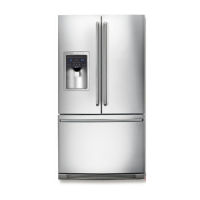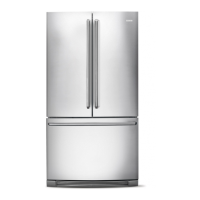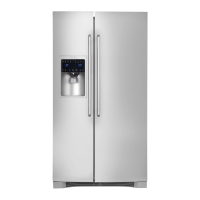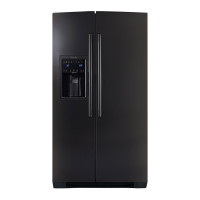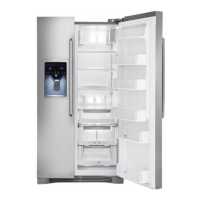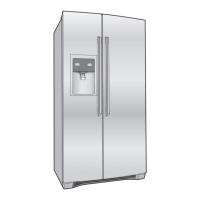Do you have a question about the Electrolux EI23BC65KS and is the answer not in the manual?
Importance of the guide, commitment to satisfaction and product quality.
Fields for purchase date, model, and serial number for quick access.
Benefits of product registration and how to register online or by mail.
Customer assistance contact information for the US and Canada.
Items to verify for doors, leveling, electrical supply, and ice maker.
Read all safety precautions before operating the unit.
Explains safety alert symbols: DANGER, WARNING, CAUTION, IMPORTANT.
Warnings about flammable liquids, explosive vapors, and ice maker parts.
Warnings about packaging materials and child entrapment in appliances.
Responsible recycling methods and steps before disposal.
Guidelines for safe electrical operation, grounding, and avoiding extension cords.
Illustration and explanation of refrigerator features and terminology.
Note that features may vary by model; illustration shown without freezer drawer cover.
Optional accessories can be purchased online or by phone.
List of necessary tools for installation.
Choosing a suitable location near an electrical outlet, away from heat.
Warning against installing in locations with extreme temperatures.
Required clearances for installation and proper air circulation.
Note about potential need for extra space if door hinges near a wall.
Doors are designed to self-close after a 20-degree opening.
Steps to align the freezer drawer seal if necessary.
Adjusting front rollers to level the cabinet and align doors.
Guidelines for ensuring cabinet stability and door alignment.
Adjusting the door stop angle between 85 and 145 degrees.
Steps to adjust door levelness using the adjustable bottom hinge.
Adjusting door height by turning the washer.
Steps to adjust the fin frame for proper contact with the guide.
Adjusting fin frame height for proper contact with its guide.
Step-by-step instructions for installing shelves in desired locations.
Shelves must be removed before moving the refrigerator.
Instructions for removing doors to fit through narrow openings.
Steps before removing doors: unplug, remove food, close doors.
Steps to remove the hinge covers.
Steps for removing refrigerator doors, including wiring.
Caution to not bend the water tube when removing it.
Note about pulling approximately five feet of water tubing.
Steps to remove the bottom hinge assembly.
Caution during reinstallation of water tube and hinge cover.
Ensure doors are safely secured to prevent injury or damage.
Instructions for removing the freezer drawer.
The drawer is heavy; lift with care.
Instructions for installing door handles on refrigerator and freezer doors.
Step-by-step guide for attaching handles using provided screws.
Verify handle leveling and ensure all screws are tightly secured.
Wear safety gloves and glasses; handle with care.
Disconnect power before connecting water supply to prevent shock.
Warnings regarding water supply materials and freezing temperatures.
Verify water supply lines comply with local plumbing codes.
List of required tools and materials for water line installation.
Step-by-step instructions for connecting the water supply.
Local building authority recommendations for water lines.
Description of the Wave-Touch™™ control panel.
Description of the IQ-Touch™™ control panel.
Explains the three screen levels of the Wave-Touch™™ control panel.
Ice must be transferred or discarded if the ice maker is off.
Standby mode displays only water, cubes, and crushed options.
Control panel activates by touch, returns to standby after inactivity.
Explanation of options: vacation mode, filter status, temperature display.
Steps to adjust temperatures using the control panel.
Functionality and usage of Sabbath mode.
Explains door ajar, high temp, and power fail alarms.
How to disable Perfect Temp™™ drawer before Sabbath mode.
Touchscreen controls for dispenser and options.
Turning the ice maker on or off.
Accelerates freezing and increases ice production.
Controls the dispenser light.
Locks controls to prevent unintended changes.
Conserves energy by extending defrost cycles.
Displays filter status and allows reset after changing.
Displays filter status and allows reset after changing.
Toggles between Fahrenheit and Celsius temperature display.
Disables control panel tones, keeps warning signals active.
Resets all refrigerator settings to factory defaults.
Turns off the cooling system for cleaning.
Pressing on/off does not disconnect power; unplug the cord.
Ice must be transferred or discarded if the ice maker is off.
Adjusting refrigerator and freezer temperatures via the control panel.
Explains door ajar, high temp, and power fail alarms.
Instructions for preparing the water supply system for the dispenser.
Water pressure recommendations for proper dispenser and filter function.
Water dispenser has an auto-shutoff after 3 minutes of continuous use.
How the ice maker works and initial setup.
Ice maker activates at factory; disable if no water supply.
Turning off the ice maker will melt existing ice.
Turning off the ice maker disables the ice dispenser.
Ice maker has a sensor arm that stops production when bin is full.
Preparing water supply system and initial ice production.
Ice maker may produce small cubes due to low pressure or filter.
Advice on connecting water supply and normal operating sounds.
Water softening treatment may damage the ice maker.
Instructions for cleaning the ice maker and ice compartment.
Steps to remove the ice compartment for cleaning.
Never use pointed instruments to break up ice.
Loosening stuck ice with hot water and ensuring dryness.
Do not rotate the auger when removing/replacing the ice compartment.
Models may allow installing an additional ice maker.
How the ice maker functions and initial setup.
Ice maker activates at factory; disable if no water supply.
Using the metal sensor arm to control the ice maker.
Advice for situations with no water supply or stale ice.
Smart feature for increased ice production.
Water softening treatment may damage the ice maker.
Regular cleaning of the ice maker and compartment.
When to remove and empty ice compartment due to melting or infrequent use.
Do not use pointed instruments to break up ice.
Loosening stuck ice with hot water and ensuring dryness.
Information regarding the refrigerator shelves.
Handle tempered glass shelves with care to avoid injury.
Note that shelf features may vary by model.
Step-by-step guide for repositioning shelves.
Shelves must be removed before moving the refrigerator.
Drawers for fresh food storage, located in the lower compartment.
Features of the fruit and vegetable drawers.
How to open the fruit and vegetable drawer.
Adjusting humidity for optimal storage of fruits and vegetables.
How to adjust the humidity control slide.
Meat requiring more than two days storage should be frozen.
Storage for items like wine bottles.
Drawer for short-term storage of bulk food items.
Drawer designed to maintain precise food temperatures.
Steps to turn on and adjust the Perfect Temp™™ drawer.
Do not clean the Perfect Temp™™ panel with abrasive cleaners.
Do not immerse the Perfect Temp™™ drawer lid in water.
Steps for removing the drawer for cleaning.
How to remove the drawer.
Drawer turns off with refrigerator and reactivates upon restart.
Modular door compartments for storage, removable for cleaning.
Steps to reposition adjustable door shelves.
Information on accessories like bottle retainers.
Prevents tall containers from falling out of door compartments.
Allows safe and efficient storage of canned beverages.
Features of the freezer section.
Information about freezer baskets.
Steps to remove the middle freezer basket.
Steps to remove the bottom freezer basket.
Compartment for slightly higher temperatures, ideal for ice cream.
How to remove the drawer dividers.
Tips for storing fresh foods, fruits, vegetables, and meat.
Optimal temperatures and avoiding overpacking the refrigerator.
Using humidity drawers and proper storage techniques.
Proper wrapping and storage for meat and poultry.
Maintaining optimal freezer temperature and efficiency.
Using appropriate materials to prevent freezer burn.
Using fast freeze function for new groceries.
Tips for saving energy through installation and usage.
Refrigerator placement and leveling for energy efficiency.
Reference to the Controls section for temperature settings.
Avoiding overpacking and minimizing door openings.
Explains common sounds produced by refrigerator components.
Refrigerator's energy-efficient foam is not a sound insulator.
Normal red glow on back wall during automatic defrost.
Information on the PureAdvantage™™ water filter and its certifications.
Location of the water filter in the fresh food compartment.
Step-by-step guide for replacing the water filter.
Pressing the water filter button to release the cartridge.
Unwinding the new filter and removing protective caps.
Removing caps from the new water filter cartridge.
Ensuring the filter cartridge is properly seated.
Steps after installing the new water filter.
Location of the air filter.
Steps for replacing the air filter.
Visual indication of the air filter location.
How to order replacement filters by phone or online.
Keeping the refrigerator clean to maintain appearance and prevent odors.
List of cleaning agents to avoid on refrigerator components.
Electrical components remain active until the power cord is unplugged.
Safety precautions when moving the refrigerator.
Drain water supply system if moving in freezing temperatures.
Advice for leaving the refrigerator during vacations or moving.
Guide for cleaning different parts of the refrigerator.
Function of the ice chute extension.
Steps to remove and clean the ice chute extension.
Steps to install the ice chute extension.
Instructions for replacing LED lights in the refrigerator.
Information on ordering replacement LED lights.
LED lights are connected in series; failure of one may affect others.
Guide to common problems, causes, and solutions.
Problems with ice production, insufficient ice, and frozen cubes.
Problems with the ice dispenser not dispensing or being jammed.
Troubleshooting steps if the interior light is not working.
Solutions for interior odors and how to prevent them.
Problems with doors not closing and drawers being difficult to move.
Issues with the compressor not running or running too long.
Potential causes and solutions for flashing temperature indicators.
Issues with the freezer or refrigerator being too cold.
Cause and solution for food freezing in drawers.
Cause and solution for food freezing in the meat drawer.
Issues with the freezer or refrigerator temperatures being too high.
Problems with the water dispenser not dispensing or water quality.
Causes and solutions for moisture or frost buildup inside the refrigerator.
Details of the limited warranty for parts and labor.
Items not covered by the appliance warranty.
Legal disclaimers and limitations regarding implied warranties.
Instructions and contact information for obtaining service.
Importance of the guide, commitment to satisfaction and product quality.
Fields for purchase date, model, and serial number for quick access.
Benefits of product registration and how to register online or by mail.
Customer assistance contact information for the US and Canada.
Items to verify for doors, leveling, electrical supply, and ice maker.
Read all safety precautions before operating the unit.
Explains safety alert symbols: DANGER, WARNING, CAUTION, IMPORTANT.
Warnings about flammable liquids, explosive vapors, and ice maker parts.
Warnings about packaging materials and child entrapment in appliances.
Responsible recycling methods and steps before disposal.
Guidelines for safe electrical operation, grounding, and avoiding extension cords.
Illustration and explanation of refrigerator features and terminology.
Note that features may vary by model; illustration shown without freezer drawer cover.
Optional accessories can be purchased online or by phone.
List of necessary tools for installation.
Choosing a suitable location near an electrical outlet, away from heat.
Warning against installing in locations with extreme temperatures.
Required clearances for installation and proper air circulation.
Note about potential need for extra space if door hinges near a wall.
Doors are designed to self-close after a 20-degree opening.
Steps to align the freezer drawer seal if necessary.
Adjusting front rollers to level the cabinet and align doors.
Guidelines for ensuring cabinet stability and door alignment.
Adjusting the door stop angle between 85 and 145 degrees.
Steps to adjust door levelness using the adjustable bottom hinge.
Adjusting door height by turning the washer.
Steps to adjust the fin frame for proper contact with the guide.
Adjusting fin frame height for proper contact with its guide.
Step-by-step instructions for installing shelves in desired locations.
Shelves must be removed before moving the refrigerator.
Instructions for removing doors to fit through narrow openings.
Steps before removing doors: unplug, remove food, close doors.
Steps to remove the hinge covers.
Steps for removing refrigerator doors, including wiring.
Caution to not bend the water tube when removing it.
Note about pulling approximately five feet of water tubing.
Steps to remove the bottom hinge assembly.
Caution during reinstallation of water tube and hinge cover.
Ensure doors are safely secured to prevent injury or damage.
Instructions for removing the freezer drawer.
The drawer is heavy; lift with care.
Instructions for installing door handles on refrigerator and freezer doors.
Step-by-step guide for attaching handles using provided screws.
Verify handle leveling and ensure all screws are tightly secured.
Wear safety gloves and glasses; handle with care.
Disconnect power before connecting water supply to prevent shock.
Warnings regarding water supply materials and freezing temperatures.
Verify water supply lines comply with local plumbing codes.
List of required tools and materials for water line installation.
Step-by-step instructions for connecting the water supply.
Local building authority recommendations for water lines.
Description of the Wave-Touch™™ control panel.
Description of the IQ-Touch™™ control panel.
Explains the three screen levels of the Wave-Touch™™ control panel.
Ice must be transferred or discarded if the ice maker is off.
Standby mode displays only water, cubes, and crushed options.
Control panel activates by touch, returns to standby after inactivity.
Explanation of options: vacation mode, filter status, temperature display.
Steps to adjust temperatures using the control panel.
Functionality and usage of Sabbath mode.
Explains door ajar, high temp, and power fail alarms.
How to disable Perfect Temp™™ drawer before Sabbath mode.
Touchscreen controls for dispenser and options.
Turning the ice maker on or off.
Accelerates freezing and increases ice production.
Controls the dispenser light.
Locks controls to prevent unintended changes.
Conserves energy by extending defrost cycles.
Displays filter status and allows reset after changing.
Displays filter status and allows reset after changing.
Toggles between Fahrenheit and Celsius temperature display.
Disables control panel tones, keeps warning signals active.
Resets all refrigerator settings to factory defaults.
Turns off the cooling system for cleaning.
Pressing on/off does not disconnect power; unplug the cord.
Ice must be transferred or discarded if the ice maker is off.
Adjusting refrigerator and freezer temperatures via the control panel.
Explains door ajar, high temp, and power fail alarms.
Instructions for preparing the water supply system for the dispenser.
Water pressure recommendations for proper dispenser and filter function.
Water dispenser has an auto-shutoff after 3 minutes of continuous use.
How the ice maker works and initial setup.
Ice maker activates at factory; disable if no water supply.
Turning off the ice maker will melt existing ice.
Turning off the ice maker disables the ice dispenser.
Ice maker has a sensor arm that stops production when bin is full.
Preparing water supply system and initial ice production.
Ice maker may produce small cubes due to low pressure or filter.
Advice on connecting water supply and normal operating sounds.
Water softening treatment may damage the ice maker.
Instructions for cleaning the ice maker and ice compartment.
Steps to remove the ice compartment for cleaning.
Never use pointed instruments to break up ice.
Loosening stuck ice with hot water and ensuring dryness.
Do not rotate the auger when removing/replacing the ice compartment.
Models may allow installing an additional ice maker.
How the ice maker functions and initial setup.
Ice maker activates at factory; disable if no water supply.
Using the metal sensor arm to control the ice maker.
Advice for situations with no water supply or stale ice.
Smart feature for increased ice production.
Water softening treatment may damage the ice maker.
Regular cleaning of the ice maker and compartment.
When to remove and empty ice compartment due to melting or infrequent use.
Do not use pointed instruments to break up ice.
Loosening stuck ice with hot water and ensuring dryness.
Information regarding the refrigerator shelves.
Handle tempered glass shelves with care to avoid injury.
Note that shelf features may vary by model.
Step-by-step guide for repositioning shelves.
Shelves must be removed before moving the refrigerator.
Drawers for fresh food storage, located in the lower compartment.
Features of the fruit and vegetable drawers.
How to open the fruit and vegetable drawer.
Adjusting humidity for optimal storage of fruits and vegetables.
How to adjust the humidity control slide.
Meat requiring more than two days storage should be frozen.
Storage for items like wine bottles.
Drawer for short-term storage of bulk food items.
Drawer designed to maintain precise food temperatures.
Steps to turn on and adjust the Perfect Temp™™ drawer.
Do not clean the Perfect Temp™™ panel with abrasive cleaners.
Do not immerse the Perfect Temp™™ drawer lid in water.
Steps for removing the drawer for cleaning.
How to remove the drawer.
Drawer turns off with refrigerator and reactivates upon restart.
Modular door compartments for storage, removable for cleaning.
Steps to reposition adjustable door shelves.
Information on accessories like bottle retainers.
Prevents tall containers from falling out of door compartments.
Allows safe and efficient storage of canned beverages.
Features of the freezer section.
Information about freezer baskets.
Steps to remove the middle freezer basket.
Steps to remove the bottom freezer basket.
Compartment for slightly higher temperatures, ideal for ice cream.
How to remove the drawer dividers.
Tips for storing fresh foods, fruits, vegetables, and meat.
Optimal temperatures and avoiding overpacking the refrigerator.
Using humidity drawers and proper storage techniques.
Proper wrapping and storage for meat and poultry.
Maintaining optimal freezer temperature and efficiency.
Using appropriate materials to prevent freezer burn.
Using fast freeze function for new groceries.
Tips for saving energy through installation and usage.
Refrigerator placement and leveling for energy efficiency.
Reference to the Controls section for temperature settings.
Avoiding overpacking and minimizing door openings.
Explains common sounds produced by refrigerator components.
Refrigerator's energy-efficient foam is not a sound insulator.
Normal red glow on back wall during automatic defrost.
Information on the PureAdvantage™™ water filter and its certifications.
Location of the water filter in the fresh food compartment.
Step-by-step guide for replacing the water filter.
Pressing the water filter button to release the cartridge.
Unwinding the new filter and removing protective caps.
Removing caps from the new water filter cartridge.
Ensuring the filter cartridge is properly seated.
Steps after installing the new water filter.
Location of the air filter.
Steps for replacing the air filter.
Visual indication of the air filter location.
How to order replacement filters by phone or online.
Keeping the refrigerator clean to maintain appearance and prevent odors.
List of cleaning agents to avoid on refrigerator components.
Electrical components remain active until the power cord is unplugged.
Safety precautions when moving the refrigerator.
Drain water supply system if moving in freezing temperatures.
Advice for leaving the refrigerator during vacations or moving.
Guide for cleaning different parts of the refrigerator.
Function of the ice chute extension.
Steps to remove and clean the ice chute extension.
Steps to install the ice chute extension.
Instructions for replacing LED lights in the refrigerator.
Information on ordering replacement LED lights.
LED lights are connected in series; failure of one may affect others.
Guide to common problems, causes, and solutions.
Problems with ice production, insufficient ice, and frozen cubes.
Problems with the ice dispenser not dispensing or being jammed.
Troubleshooting steps if the interior light is not working.
Solutions for interior odors and how to prevent them.
Problems with doors not closing and drawers being difficult to move.
Issues with the compressor not running or running too long.
Potential causes and solutions for flashing temperature indicators.
Issues with the freezer or refrigerator being too cold.
Cause and solution for food freezing in drawers.
Cause and solution for food freezing in the meat drawer.
Issues with the freezer or refrigerator temperatures being too high.
Problems with the water dispenser not dispensing or water quality.
Causes and solutions for moisture or frost buildup inside the refrigerator.
Details of the limited warranty for parts and labor.
Items not covered by the appliance warranty.
Legal disclaimers and limitations regarding implied warranties.
Instructions and contact information for obtaining service.
| Brand | Electrolux |
|---|---|
| Model | EI23BC65KS |
| Category | Refrigerator |
| Total Capacity | 22.6 cu. ft. |
| Finish | Stainless Steel |
| Ice Maker | Yes |
| Water Dispenser | Yes |
| Energy Star Certified | Yes |
| Door Alarm | Yes |
| Adjustable Shelves | Yes |
| Type | Side by Side |
| Height | 69 7/8 inches |

